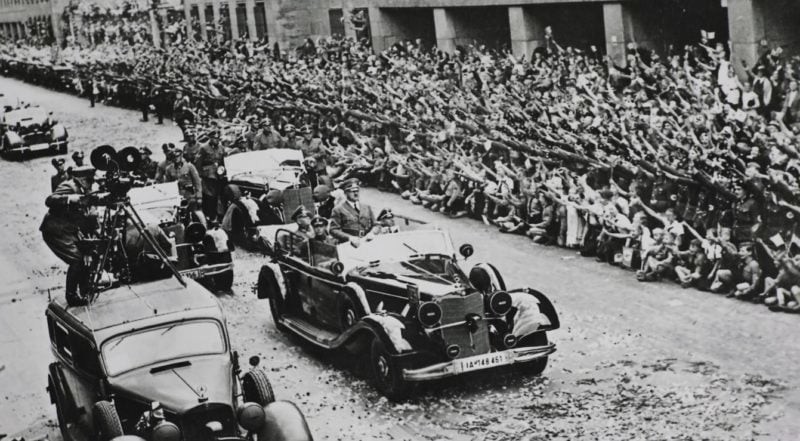Throughout history, certain vehicles become infamous not just for their engineering or design, but for their association with notorious figures. While dictators and despots often favored luxury cars to project power, few are as intertwined with dark historical events as the Mercedes-Benz 770K, particularly those owned by Adolf Hitler. This week, we delve into the story of this imposing machine, a vehicle that is both a symbol of automotive excellence and a chilling artifact of World War II.
The Mercedes-Benz 770K, often dubbed the “Grosser Mercedes” (Grand Mercedes), was the pinnacle of pre-war automotive luxury and engineering. Its sheer size, powerful engine, and opulent appointments made it a favorite among heads of state, dignitaries, and, infamously, leaders of the Nazi regime. Among the fleet of Mercedes-Benz vehicles used by Adolf Hitler, chassis number 189744 stands out due to its specific purpose and documented history.
Originally commissioned by Erich Kempka, Hitler’s personal chauffeur, this particular 770K was designated the “fourth Führer-Car” by the factory. However, unlike other Mercedes vehicles in Hitler’s possession used for daily transport, this open-top tourer was primarily reserved for state occasions and visits from foreign dignitaries. It served as a symbol of power and prestige, transporting not only Hitler but also some of the most notorious figures of the era.
Given its role in transporting high-profile individuals during a tumultuous period, security was paramount. This 770K was equipped with state-of-the-art protection for its time, including thick bulletproof glass and reinforced armor plating. Capable of withstanding 30mm shells and featuring pop-up armor plates, this convertible offered a paradoxical blend of ostentatious display and formidable protection. The open-top design, seemingly at odds with security concerns, served the propagandistic purpose of allowing Hitler to be seen by and wave to crowds, a crucial aspect of his public image.
Image: The Mercedes-Benz 770K, chassis number 189744, parading through Munich in 1940 with Adolf Hitler and Benito Mussolini, showcasing its use in significant Nazi propaganda events.
The documented wartime service of this Mercedes-Benz 770K highlights its presence at several key historical junctures. On June 18, 1940, it carried Hitler and Mussolini side-by-side during a parade in Munich, a powerful visual symbol of the Axis alliance. Following the fall of France, the car was again used for a victory parade in Berlin on July 6, 1940, marking Nazi Germany’s dominance over Western Europe. Its final documented parade appearance occurred on May 4, 1941, after the conquests of Yugoslavia and Greece, further cementing its role in Nazi propaganda and displays of power.
As the tide of World War II turned and Allied bombing intensified in 1943, production of the Mercedes-Benz 770K ceased due to heavy damage sustained by the Sindelfingen factory. By 1945, with the collapse of Nazi Germany, the US Army seized numerous Nazi vehicles as war trophies, including this very 770K. Instead of destruction, the car was repurposed, becoming part of a US Army officer motor pool in France. Imagine the symbolic weight for Allied soldiers driving a car once used by the enemy, a tangible representation of victory.
Image: Post-war scene featuring the Mercedes-Benz 770K utilized by US Army officers, symbolizing its transformation from a Nazi symbol of power to a war trophy of the Allied forces.
The post-war journey of this Mercedes-Benz 770K took several unexpected turns. In a peculiar chapter, it was traded by Belgian tobacco company owner A.H. Vander Elst, Jr. for $1,800 worth of tobacco amidst post-war scarcity. Tom N. Austin, the recipient, then donated it to a Veterans of Foreign Wars branch as a war relic. However, lacking the resources for maintenance, the car fell into disrepair and was relegated to a shed.
Rediscovered in 1976 by classic car collectors Steve Munson and Joe Ogden, initially under the false impression it belonged to Heinrich Himmler, the car’s true identity and historical significance were soon revealed. Recognizing its importance, they undertook a full restoration to its original factory condition. Following restoration, the Mercedes-Benz 770K became a traveling exhibit, appearing in numerous museums and attracting significant attention. Casino magnate Ralph Engelstad acquired it in 1983 for his Imperial Palace Auto Collection in Las Vegas, further cementing its status as a unique historical artifact.
After Engelstad’s passing in 2002, the car returned to Europe as part of a large private collection. Now, almost eight decades after its creation, this Mercedes-Benz 770K went up for auction through Worldwide Auctioneers in Scottsdale, Arizona. While no official estimate was publicly disclosed, previous appraisals valued it in excess of one million dollars, reflecting its rarity and historical weight.
While the ethical implications of owning a vehicle so closely linked to Adolf Hitler are complex, there is a compelling argument for preserving it as a tangible piece of history. This Mercedes-Benz 770K is not merely a car; it is a rolling museum exhibit, a stark reminder of a dark period in human history and the machinery of power. Furthermore, the auction included a commitment to donate 10% of the sale price to Holocaust education, transforming a symbol of infamy into a tool for learning and remembrance. This adds a layer of redemption to the car’s story, suggesting that even artifacts of evil can be repurposed for good. The Mercedes-Benz 770K remains a complex and controversial vehicle, but undeniably a significant piece of both automotive and world history.

